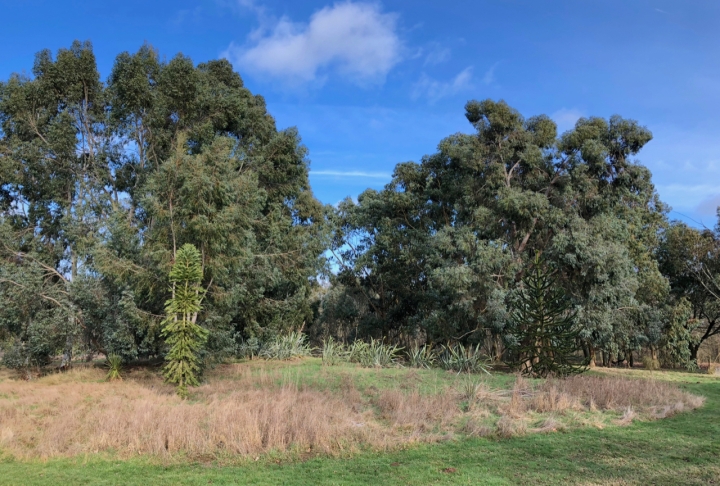
February 2019 — A sharp breeze sweeps across the hill, ruffling the silver-green eucalyptus grove in the distance. It forcefully combs the grasses and buffers the young monkey-puzzle trees that are dotted around the meadow. The air is crisp and the sky is clear. Apart from the hissing of the wind in the branches, there is barely a sound. Gondwanaland, on the western fringe of the Marks Hall estate, feels a bit otherworldly.
The area is named after Gondwana, the primeval continent in the southern hemisphere that merged with the Pangea before breaking up to give birth to the Australasian, Indian and South American plates. Situated on the brow of a hill, Gondwanaland suffered badly in the 1987 hurricane and was redesigned with species mostly from down-under.
The eucalyptus are perhaps the most obvious southern-hemisphere reference. More than 200 have been planted since the project started in 1999. The E. pauciflora ssp. debeuzevillei, in large thickets at the entrance to the area, are now more than 10m tall, their ochre-grey peeling bark lying in strips on the ground. Further away, the E. dalrympleana, are towering at what looks like 15m.

Marks Hall’s Gondwanaland is also getting known for its collection of Wollemi pines, Wollemia nobilis, a species dating from the Cretaceous period, which have been planted on the woodland edge and look like a display of oversized bottlebrushes.
This relation of the Araucaria, the monkey-puzzle tree, was thought to be extinct until a botanical expedition in the Wollemi National Park, north of Sydney, happened across a few specimens in a remote canyon in 1994. Seeds were later collected and made available to several botanic gardens around the world, including the arboretum at Marks Hall. The estate planted its first Wollemi pines in 2007 and now has 80, making this what is believed to be the largest collection in Europe.
Gondwanaland is an unexpected find in the course of a visit that started with a different purpose. The reason I have dragged Dr K all the way to Essex is to experience the Millennium Walk, a winter-interest trail along one of the long man-made lakes on the other side of the estate.

The Millennium Walk is, technically, in the Asian section of the park. It’s not immediately obvious but there are hints along the way, such as the clusters of hamamelis that brighten the path with their vivid yellow flowers.

The real wow comes as we push the gate into the Millennium Walk itself, with the 71 clear-white Himalayan birches and 159 red-barked dogwoods in boisterous contrast with each other and against the buff grasses and rust-coloured shrubs.

Created in 1999, the walk is the work of landscape designer and former Marks Hall trustee Peter Thurman. It involves mainly species from China and Japan, repeated and used en masse to impressive effect. Clumps of golden-grey dried miscanthus and shiny green clusters of fragrant sarcococca line the meandering paths.
It is too early for shrubs such as Chinese hazel, Corylopsis sinensis, or stachyurus, Stachyurus praecox, or even the Chimonanthus, with its waxy flowers, to join the colourful show, but their framework of branches is a suitable backdrop for the main act provided by the white Betulas and crimson Cornus. And trees such as acers – including the paperbark maple Acer griseum – bring a stronger structure to the space as a whole. The walk isn’t very long, only about 250 metres, but it’s a very skilful and delicious immersion in the world of winter colour.

As we veer through the snowdrop-carpeted European woodland and around the back of the walled garden, the walk reveals itself again, this time from the other side of the lake, its red, white and creamy hues reflected on the shimmering water. It’s a stunning sight.
Sadly, the view can only be enjoyed sideways, because the walled garden, which the walk faces directly, is shut during the winter months. This is a double disappointment, in fact, as the sculptural hedges and banks of seed-heads we can see through the closed gates suggest that the garden, redesigned by Brita von Schoenaich 15 years ago, is another winter wonder waiting to be enjoyed. There are good reasons of course, in particular to protect the grassed areas from being compacted by visitors, so this is only a minor frustration, but opening the walled garden in the winter would also complete existing vistas and open new ones.

Further information on opening hours and on the history of the Marks Hall estate is available on the Marks Hall website.
Lovely Marks Hall!